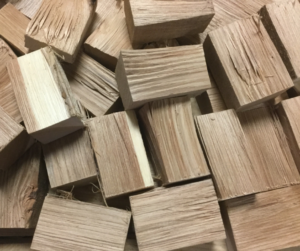 |
| BBQ Smoke color, Black, Brown White or Blue is the key to successful Barbecue flavor |
You smell it before you see it! The
aroma of foods being cooked outdoors. When those foods involve cooking
over wood – hardwood to be specific – well, it’s a flavor experience
that is in a league of its own.
Today, instead of concentrating on the cooking technique of wood-fires, let’s examine the smoke vapor.
Does BBQ smoke color mean anything for flavor outcome?
The quick answer: absolutely! Let’s take a closer look at the finer points of smoke vapor colors.
From Black to Nearly Invisible, The Language of BBQ Smoke Color
There
are four basic attributes to smoke when it leaves equipment: volume,
velocity, density, and color. It is the combination of these attributes
that reveal so much about the color of smoke vapor or gas produced from
combusted wood.
Black Smoke = No Oxygen
Black
smoke is unattractive, highly dense, consisting of large particles, and
the key sign that the wood is starved of oxygen. When air intake is
left uncorrected, this black smoke vapor can turn foods acrid, bitter,
and sooty. Certainly, this is not the goal of wood-fired cooking! Don’t
cook with smoke that is black in color. Learn how to control air intake
and exhaust for proper air flow and the best smoke vapor infusion for
great flavor.
Gray/Brown Smoke = Poor Wood Quality
You
understand air flow, the balance needed between the air intake and
outtake. Despite your optimal setting of air flow, you still find gray
to brown smoke color occurring. What happened?
Often,
this boils down to a case of poor wood choice. Gray or brown smoke
occurs when there is a mixture of moisture and hydrocarbons. Bark on
woods can stimulate brown smoke as this is the driest and most impure
part of the wood. You can also see gray to brown smoke color when there
are other stimulants on the wood. It may be that something dripped on
the wood, was deliberately applied to the wood, or as part of the wood’s
manufacturing process if the wood is a by-product from another process.
White Smoke = Initiation of Heat
Virtually
all solid materials exposed to combustion emit white smoke. This means
heat is being stimulated to the wood and drying it out. Remember, moisture
is water and when heat finds water it has to induct it to produce
steam. This takes energy from the fire or ignition and can stall full
stages of combustion. Once moisture is evaporated you will observe white
smoke to transition to a clearer color, hopefully, the infamous blue.
For longer, lower temperature cooking, wait for the white smoke stage to
pass before adding the food to the grates. For hotter temperature
cooking like burgers, steaks, etc., go ahead and add to the grates even
with the white smoke present. The abundance of aromatics at the white
stage will allow for the flavor to permeate shorter cook items.
Blue Smoke (or nearly invisible) = Holy Grail of BBQ Smoke Color
Keeping
in mind that you don’t always need an invisible or blue smoke to have a
flavorful wood-fired cooking event, this is still the goal when cooking
with wood for many hours. Blue or invisible smoke means that full
combustion has occurred to the wood and the lignin compound is releasing
the smoky aromatic that will stick to moist food surfaces. Take
advantage of this pristine stage and get cooking for the best wood-fired
flavors.
Finding the Perfect Wood with the Perfect Moisture Level for the Ideal BBQ Smoke Color
As a final note, don’t be fooled into thinking that using dry wood
will save time on waiting for the fire’s heat to evaporate excess water
and get to the flavoring. There is extensive research demonstrating
that the ideal smoke composition containing flavor stimulating compounds
called carbonyls and phenols is in hardwoods that have a higher
moisture rating not the 10% or less that is considered seasoned wood.
Use caution when making the wood purchase. Knowing key details about the wood prior to purchasing will help to achieve the smoke color that produces maximum flavor.
Was
this posting helpful? Leave a comment or suggestion. We’d love to hear
what you’d like to learn more about in wood-fired cooking methods and
techniques. Don’t forget, follow us and subscribe so you don’t miss out
on anything.


![setting up the wood chunks on the heat Diffuser to develop hot spots for Charrin [setting up the wood chunks on the heat Diffuser to develop hot spots for Charring]](https://smokinlicious.com/recipe/wp-content/uploads/2016/10/Cauliflower-diffuser.jpeg)
![Fresh heads added to the grill, note the wood has not ignited yet to develop a hot spot [ Fresh heads added to the grill, note the wood has not ignited yet to develop a hot spot]](https://smokinlicious.com/recipe/wp-content/uploads/2016/10/Cauliflower-showing-the-wood.jpeg)
![Now I have hot spots, and look a the char we are putting on the cauliflower. The green is the Parsley I add at the end of the process [Now I have hot spots and look a the char we are putting on the wood fired cauliflower. The green is the Parsley I add at the end of the process]](https://smokinlicious.com/recipe/wp-content/uploads/2016/10/Cauliflower-blog-up-close-finished.jpg)




